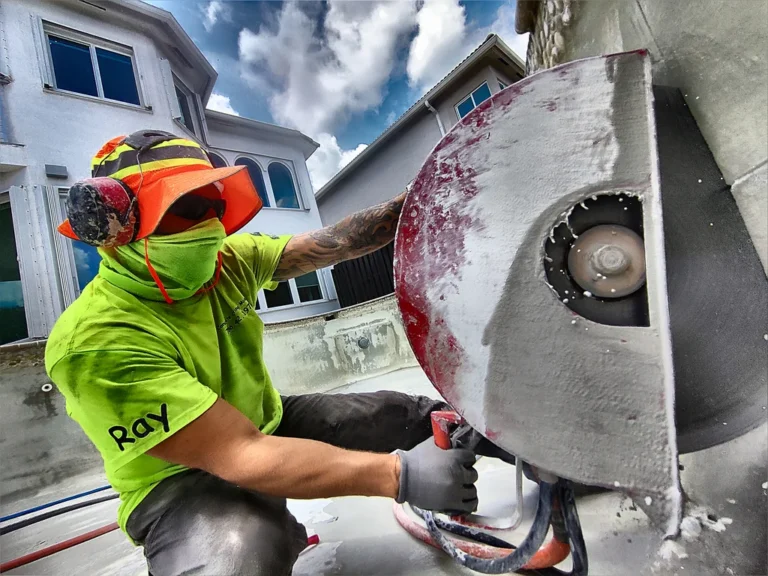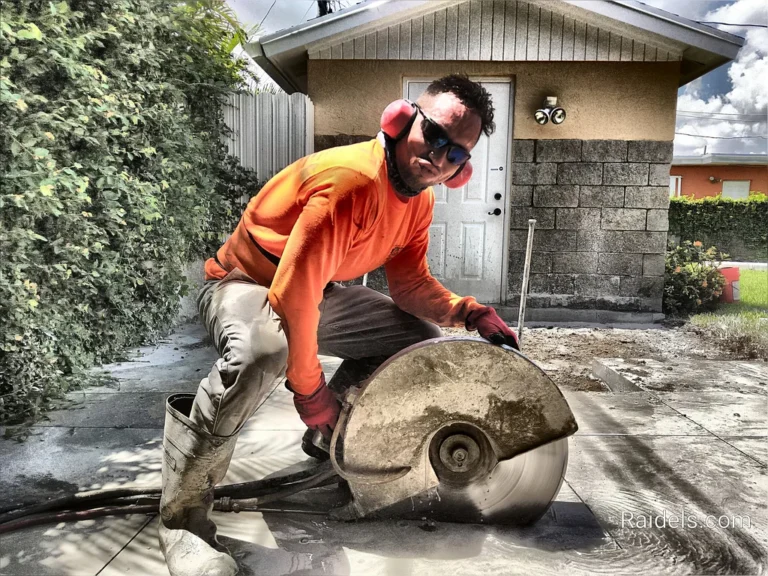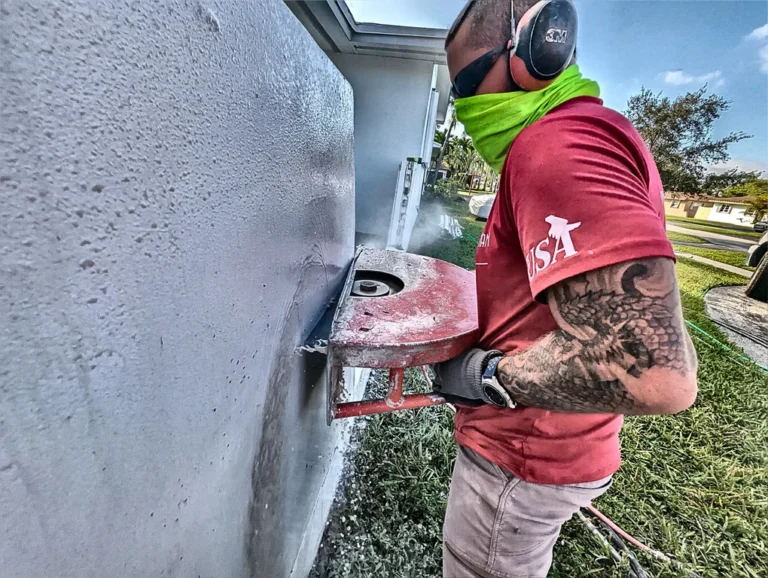For over twenty years, I’ve witnessed countless Miami homes and businesses transform. Often, that transformation involves altering the very bones of the structure – the concrete walls. Whether it’s adding a new window to capture that stunning view, creating a doorway for better flow, installing an HVAC pass-through, or even crafting a modern serving hatch between rooms, cutting openings in concrete walls is a frequent necessity. But let me be clear: this isn’t a weekend DIY project. Cutting into concrete walls, especially in a place like Miami where structures are built robustly, demands precision, expertise, and an unwavering commitment to safety. One wrong move can compromise structural integrity, lead to costly repairs, or worse.
So, how do the professionals approach cutting concrete walls safely and effectively? Let’s break down the process from an expert’s perspective.
Why Cut Openings in Concrete Walls?
The motivations are diverse, often driven by renovation or functional needs:
- New Windows/Doors: Adding natural light, improving ventilation, enhancing views, or creating new access points are primary drivers. The process involves how to cut window openings in concrete walls or door openings with precision.
- Enlarging Existing Openings: Making current windows or doors larger for aesthetic or functional upgrades. See how experts handle unlocking space mastering door enlargements.
- Utility Penetrations: Creating passages for plumbing, electrical conduits, or HVAC ductwork.
- Architectural Features: Adding pass-throughs, recessed niches, or other design elements.
The Unique Challenges of Wall Cutting
Unlike cutting a simple slab on grade, modifying walls presents distinct challenges:
- Structural Integrity: Walls, particularly exterior ones or interior shear walls, are often load-bearing. Cutting into them improperly can compromise the building’s stability. This is not the time for guesswork.
- Reinforcement (Rebar): Miami construction frequently involves reinforced concrete walls (CMU block fill or poured concrete) containing rebar. Cutting through this requires specialized blades and techniques, similar to those discussed in can a concrete saw cut through rebar.
- Embedded Utilities: Walls can conceal electrical wiring, plumbing pipes, and communication lines. Accidentally cutting these can be dangerous and expensive.
- Precision Required: Openings for windows and doors need to be perfectly plumb, level, and dimensionally accurate for proper installation.
- Dust and Slurry Control: Managing dust (especially hazardous silica dust) and water slurry in a vertical or indoor environment requires meticulous containment. Learn about the hidden dangers of cutting concrete walls silica dust and respiratory health.
Phase 1: Meticulous Planning & Preparation
Success starts long before the saw touches the wall. Rushing this phase is asking for trouble.
Structural Assessment
- Load-Bearing Analysis: The absolute first step is determining if the wall is load-bearing. This often requires consulting original blueprints or, more reliably, engaging a structural engineer. They will assess the loads carried by the wall and determine if temporary shoring/support is needed during and after cutting, and specify any required lintels or headers to bridge the new opening. Never cut into a potentially load-bearing wall without professional structural assessment.
- Permitting: Most municipalities in Miami-Dade require permits for structural modifications, including creating new openings in concrete walls. Professionals handle the application process, ensuring compliance with local building codes.
Locating Hidden Obstacles
- Utility Locating: Before marking any cut lines, use professional utility locating services or Ground Penetrating Radar (GPR) to identify any embedded electrical conduits, plumbing pipes, or other utilities within the wall cavity.
- Rebar Mapping (GPR): GPR scanning is also invaluable for mapping the rebar grid within the concrete. Knowing the location and depth of reinforcement helps plan the cuts, anticipate challenges, and select the appropriate cutting blades and techniques.
Site Preparation
- Protection: Cover floors, furniture, and adjacent areas with plastic sheeting and tape to protect from dust and water slurry.
- Containment: Set up systems to manage water runoff and slurry collection, especially for indoor work.
- Access: Ensure clear, safe access for personnel and equipment. This might involve setting up scaffolding or lifts for higher openings.
Phase 2: The Execution – Precision Cutting Techniques
With thorough planning complete, the cutting can commence using specialized methods:
Wall Sawing: The Precision Powerhouse
For larger, perfectly straight openings (windows, doors, large utility passages), track-mounted wall saws are the gold standard.
- How it Works: A powerful saw head with a diamond blade travels along a track bolted securely to the wall. This ensures perfectly plumb and level cuts with clean edges.
- Advantages: High precision, capable of cutting significant depths, remote operation often possible (enhancing safety). Ideal for concrete wall sawing in Miami precision cuts for every project.
- Considerations: Requires secure mounting, space for the track system, and robust power supply. Wet cutting is standard.
Hand Sawing / Chain Sawing: Versatility for Complex Cuts
For smaller openings, tight corners, over-cut prevention, or areas inaccessible to wall saws, specialized hand-held saws are employed.
- Types: Includes heavy-duty circular saws with diamond blades, cut-off saws, and powerful hydraulic or electric concrete chainsaws. Hydraulic chain saw options offer fume-free power ideal for indoor work.
- Advantages: Highly versatile, can make plunge cuts, create irregular shapes, and work in confined spaces. Essential tools found in the arsenal of experts using Hand Saw Tools.
- Considerations: Requires significant operator skill and strength for precise, safe operation. Depth may be limited compared to wall saws. Effective dust control (integrated vacuum or wet cutting) is critical.
The Cutting Process Overview
- Layout: Precisely mark the opening on the wall based on plans.
- Support (If Required): Install temporary shoring as specified by the structural engineer.
- Cutting: Make precise cuts along the layout lines using the chosen method (wall saw or hand saw). Often involves multiple passes for thick walls. Over-cutting corners is generally avoided to maintain integrity; smaller hand saws might finish corners.
- Piece Removal: Once cut, the concrete section is carefully broken (if needed) and removed. Large pieces might require lifting equipment.
- Edge Finishing: Ensure edges are clean and meet project specifications.
Phase 3: Safety – The Uncompromising Priority
Cutting concrete walls involves inherent risks that demand strict safety protocols:
- Structural Support: Incorrectly cutting or failing to support a load-bearing wall can lead to partial or catastrophic collapse. Engineer-approved shoring is non-negotiable when required.
- Silica Dust Control: As emphasized before, meticulous dust control (wet methods, HEPA vacuums) and respiratory protection are essential.
- Blade Safety: Wall and hand saws are powerful tools. Operators need proper training, PPE (eye, hearing, respiratory protection, gloves, sturdy footwear), and awareness of kickback potential.
- Falling Debris: Secure the work area below the cutting zone to prevent injury from falling concrete pieces.
- Utility Strikes: Despite locating efforts, extreme caution is needed to avoid hitting unforeseen embedded objects.
Wall Cutting: Not a DIY Endeavor
Given the structural implications, the need for specialized equipment, and the significant safety hazards (especially silica dust and potential collapse), cutting openings in concrete walls falls firmly into the “hire a professional” category. The risks associated with getting it wrong are simply too high. Concrete cutting and demolition diy vs professional services clearly leans professional for this task.
Experienced Miami concrete cutting contractors bring:
- Structural Understanding: Assessing wall types and load implications.
- The Right Tools: Wall saws, hydraulic hand saws, GPR scanners.
- Safety Expertise: Implementing proper dust control, shoring, and operational safety.
- Efficiency & Precision: Completing the job accurately and minimizing disruption.
- Insurance & Licensing: Providing peace of mind and ensuring compliance.
Bringing more light or better access into your Miami property by creating openings in concrete walls is achievable and transformative, but only when approached with the right expertise and respect for the structure. Trust the professionals to handle it safely and effectively.
- The Right Tools: Wall saws, hydraulic hand saws, GPR scanners.
- Safety Expertise: Implementing proper dust control, shoring, and operational safety.
- Efficiency & Precision: Completing the job accurately and minimizing disruption.
- Insurance & Licensing: Providing peace of mind and ensuring compliance.
Bringing more light or better access into your Miami property by creating openings in concrete walls is achievable and transformative, but only when approached with the right expertise and respect for the structure. Trust the professionals to handle it safely and effectively.



